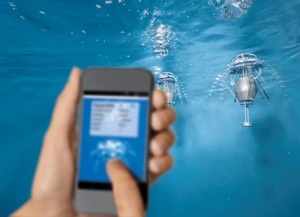Festo presented the AquaJellies for the first time at the Hanover Fair in 2008. Now, Festo presents the AquaJellies 2.0 with improved communications technology and condition monitoring of the individual jellyfish on a smartphone.
 Integrated platform: Model for lightweight construction, energy efficiency system capability and integrated communication technologies
Integrated platform: Model for lightweight construction, energy efficiency system capability and integrated communication technologies
Festo’s AquaJellies are artificial, autonomous jellyfishes with electric drive and an intelligent, adaptive mechanical system. The AquaJellies were developed as part of the Bionic Learning Network. The autonomous jellyfishes, which are equipped with communicative capabilities, embody innovative developments in the areas of system capabilities, energy efficiency, communication and lightweight construction.
These technological showpieces consist of a translucent hemisphere and eight tentacles which provide forward thrust. A watertight, laser sintered pressure hull is located at the middle of the AquaJelly. This encloses a central electric drive, two rechargeable lithium-ion-polymer batteries of the same size as smartphone batteries, a charging controller and servomotors for the swash plate.
AquaJellies 2.0 and the real-time monitoring on a smartphone
An app can be used to individually record and track the current condition of each AquaJelly. Thanks to real-time diagnostics, it is possible to make a parameter query about the current battery status, the temperature, the current power consumption and the depth of the jellyfish in the water. A movement profile also shows in which direction the jellyfish in question is swimming.
Avoiding collisions
Each artificial jellyfish decides autonomously which action it will take on the basis of its own status, which depends upon, for example, charge level and drive position, as well as its proximity to other jellyfishes. Transferring this principle to the field of automation makes it possible for many autonomous or semi-autonomous, intelligent systems to work together, and to execute large tasks with small systems, which act together in a targeted fashion.
Bionic technology bearers for the water technology sector
Festo is using these bionic technology bearers to visualise potential and ideas of how efficient systems in the field of water technology may look in the future. Process monitoring and condition monitoring are important topics in all equipment used in the process industry and hence also in the water technology sector.